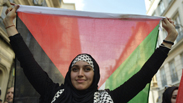Khaled Mashal, sitting pretty in Qatar, might not really care, but Hamas in Gaza - including the head of its military wing, Mohammad Deif – could not bear ideological, theological or practical alienation from Gaza's residents, nor an impotent rule.
Hamas is well aware that both of these phenomena played a direct role in the downfall of the Egyptian government's short-lived rule by Mohamed Morsi of the Muslim Brotherhood, Hamas' parent organization. Thus they are afraid, and rightly so, of suffering a similar fate should the Gazan population rise up against them. This could serve Israel well if it allowed the resentment that already exists among civilians in Gaza to develop and intensify into a widespread phenomenon.
If Israel succeeds in this effort, this may be the lever by which Israel, with the assistance of the international community, enforces not only a Hamas ceasefire, but even (believe it or not) the demilitarization and reconstruction of Gaza, creating some good years of deterrence.
The above assessment is based on experience gained by the US and NATO in Israel and elsewhere in the Middle East. What happened in Lebanon, Iraq and Afghanistan in recent years proves that radical Islamic organizations, especially political Islamic organizations such as Hamas and Hezbollah, have three major leverage points that can be used against them:
1. Immediate threat to the lives of senior political and military leaders. Not the elimination of one or two, but rather hitting four or five within a short period of time. This is what the Shin Bet and the IDF did in 2004 during the Second Intifada and the US did with drones against the Taliban and al-Qaeda in both Afghanistan and Yemen.
2. The whim of the "patron". This is usually an external country or countries financing and aiding the Islamic organization. When its Iranian patron so desires, Hezbollah fires; when its Qatari patron is amenable, Hamas agrees to a ceasefire.
3. The welfare of the population. Political Islam, in contrast to global jihad, seeks not only to establish an Islamic caliphate as ISIS does. First and foremost, like the Muslim Brotherhood, it aims to cement its religious dominance through social reform. This is as true for Hamas as it is for Hezbollah. Therefore, both movements maintain a social welfare system that has not only branched into organizational and military infrastructure, but is the main source of its political power and popularity.
Therefore, Hamas cannot cope for long with an enraged population. So how does this relate to Israel in the current situation?
Quite simply, Israel must recognize that turning Gaza's population against Hamas is the only means it now has to affect the organization. The wholesale elimination of Hamas officials by the Shin Bet and IDF is not possible at the moment, as they are hiding in deep bunkers under solid layers of the sick, women, children and the elderly. There is limited ability to pressure Hamas and Islamic Jihad through their patrons, Iran, Qatar and Turkey. All that remains is the Gazan people, who have a decisive influence on Hamas.
But the Gaza people cannot currently speak out. Firstly, because Israel is bombing, shelling and sending armored troops into their territory. The Palestinians have been forced to flee en masse for their lives and those who are busy running for their lives are too busy, both physically and mentally, to flood the streets to demand their rights, in particular when it comes to rulers who do not hesitate to shoot their own citizens.
Secondly, the popular rage is currently directed against Israel. This is natural. The Gazans are angry at those who have directly wrought this destruction and loss of life. Israel needs to create a situation in which the negative emotional energy of the Palestinians in Gaza is not directed against it, but rather against Hamas.
Therefore, what is needed now is a stable ceasefire that will allow Gazans to leave the shelters provided by UNRWA, to walk around the shattered neighborhoods, and absorb what they see there. I recently visited Khan Younis and saw what Gazans have not yet seen and will only see after a ceasefire. The destruction is enormous, not only in Gaza City and nearby neighborhoods, but all over the Gaza Strip.
I saw the Dahiyeh neighborhood of Beirut in 2006, after the Air Force had been there, and I can say that that was a drop in the ocean compared to what is happening now in Gaza. People will have to work for at least a year to have a roof over their heads and access to running water and proper sewage facilities.
But to make this sink into the consciousness of Gazans there needs to be a ceasefire. Therefore, Israel should, after coordination with Egypt, the United States and Jordan, declare a unilateral truce. The IDF should launch aerial assaults only against specific targets, such as the rocket launchers, which are operated by Hamas, but the ground forces will leave the built-up areas and deploy to the open farmland between the Gaza border fence and the built-up areas - a "security zone" in which there will be less friction between IDF troops and Hamas men who are swarming underground and carrying out terror attacks.
In this way, the IDF can make use of the full firepower of tanks moving rapidly from place to place, that are protected against anti-tank weapons - namely the "windbreaker". They are also able to ensure that Hamas is not digging tunnels under their noses. All of this should be implemented, until a permanent agreement is reached that will bring long-term quiet and a needed level of deterrence.
But in order for that to happen, international and regional cooperation is required. This cooperation must offer the Gazan population a massive incentive in the form of financial aid and the opening of the Rafah crossing between Gaza and Egypt – a "Mini Marshall Plan".
Israel also needs to reach an agreement with Egypt, the US and the Europeans that the economic aid to Gaza is contingent on Hamas' responsiveness to its demand for the demilitarization of the Gaza Strip by international civilian monitors. For example, there must be oversight of the cement provided by Israel and transferred by Egypt into the Gaza Strip so that it is used only for construction and reconstruction, and not to line Hamas tunnels. This could be achieved by using European civilian inspectors in every Gazan cement plant and at the reconstruction sites.
Similar oversight should be implemented for equipment for processing metal (to prevent the production of rockets and missiles) as well as dual-use chemicals that can both be used in agricultural fertilizer and for manufacturing explosives. Let's not delude ourselves, this will not completely prevent Hamas from regrouping, but the Gazan population will be busy above ground rather than below it.
Things will improve, and even Hamas will come to the conclusion that it has something to lose before it embarks on another round of fighting. There are many more details and clauses to be included an agreement, but first, before everything else, Gazans must be allowed to leave the shelters, walk around the streets, and have their say to Haniyeh and Deif.

















